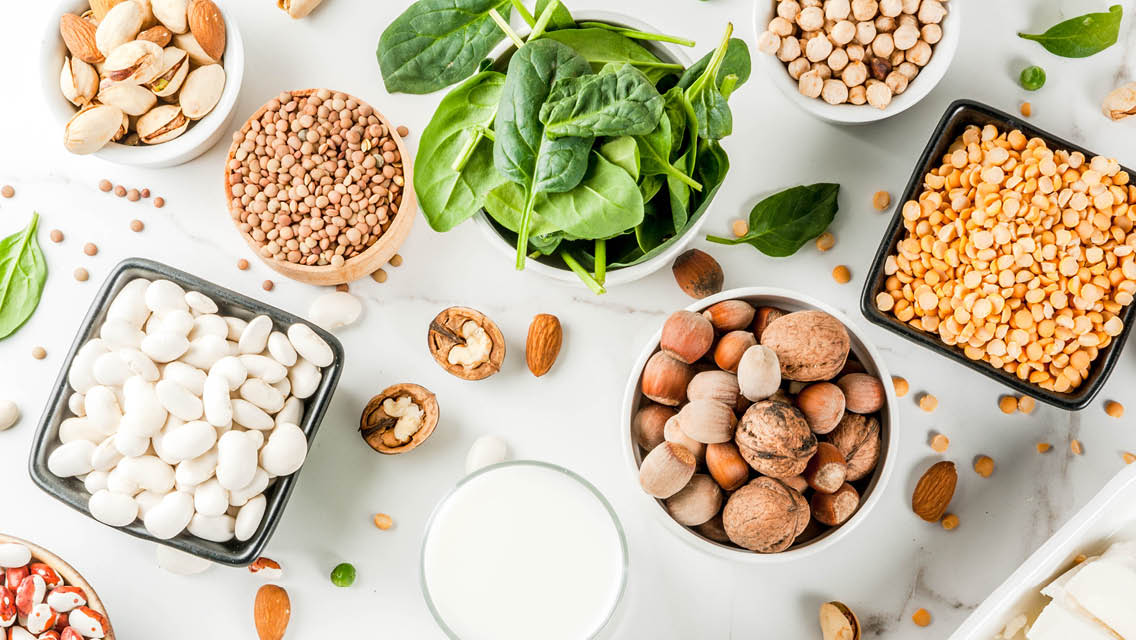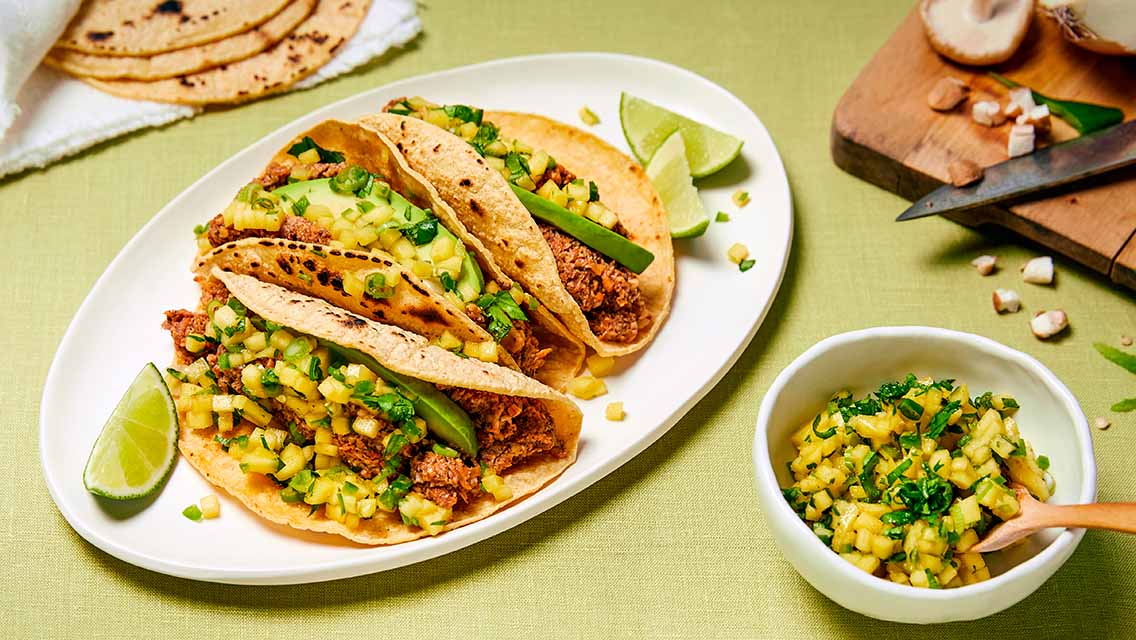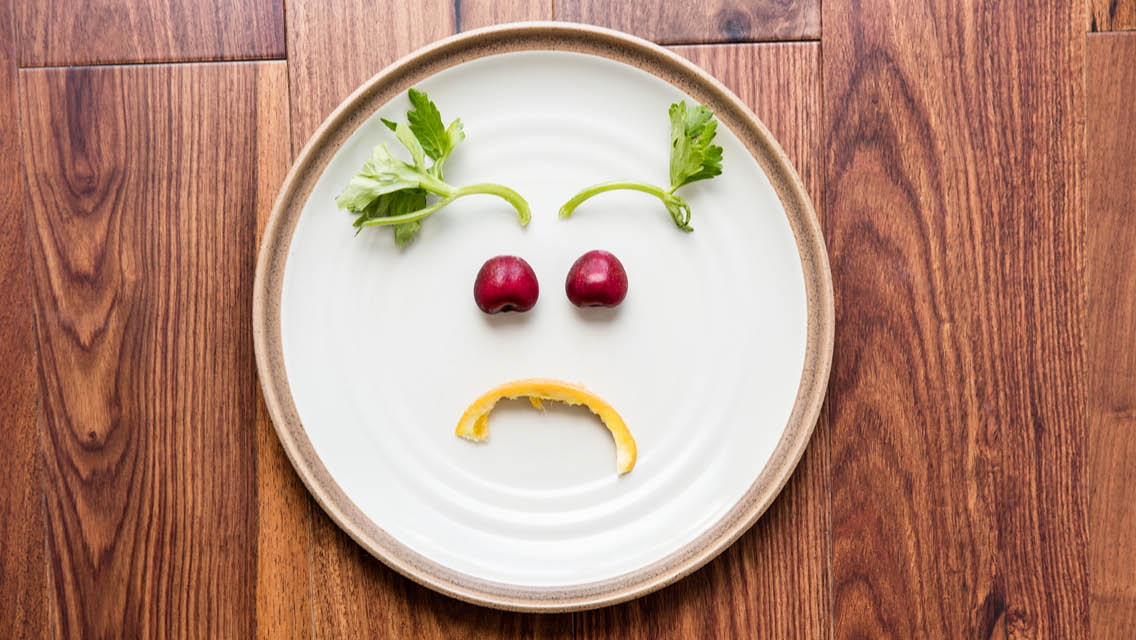Explore these sections:
In the not-so-distant past, plant-based diets were considered relatively fringe in the United States. People enjoyed meatless meals only if they had a deep interest in animal welfare or needed to save money. Most of us had never heard of an oat-milk latte or oyster-mushroom jerky.
This attitude is changing fast. As of 2020, 44 percent of American adults reported that they were trying to eat a more plant-based diet, more than 30 percent had adopted meat-free days, and more than 50 percent were drinking nondairy milk, according to a report by the Culinary Institute of America and the Harvard T. H. Chan School of Public Health.
One perspective hasn’t really changed, however: Most Americans still tend to believe that when it comes to protein, meat is the gold standard.
Yet for most people who elect to skip animal foods — occasionally or entirely — plants can easily meet their protein needs. Especially if they maintain a diverse diet.
“Essential” Vocabulary
Some of the misunderstanding of what counts as “real” protein comes from our nutrition vocabulary, particularly the idea of “complete” and “incomplete” proteins.
A protein molecule is made of amino acids, of which there are 20 types. Our bodies make 11 of these, known as “nonessential” amino acids.
The body gleans the remaining nine from food; these are known as “essential.” Any food that provides all nine essential amino acids is called a complete protein. Most complete proteins are animal-based, while relatively few plant sources (soy, quinoa, and chia seeds, among others) are considered complete by these standards.
The nutritional terms “nonessential” and “incomplete” do not mean “unnecessary” or “undesirable,” though. They create a hierarchy that inadvertently puts animal proteins at the top — but our bodies don’t see it that way.
“The idea that you need a complete set of amino acids in the same meal is not true: Our bodies are smarter than that.”
“The idea that you need a complete set of amino acids in the same meal is not true: Our bodies are smarter than that,” says Peter Horvath, PhD, associate professor emeritus of the Department of Exercise and Nutrition Sciences at the University at Buffalo. As long as we eat a variety of foods over the course of 24 to 36 hours, he says, we’re covered.
For instance, you might get seven of the amino acids at breakfast and the other two at dinner. Your body would combine them to get all the protein it needs, Horvath explains. “Evolutionarily, we’ve adapted to finding a bunch of seeds one day and grains the next.”
For those who feel they can thrive only if they eat animal protein, that may have more to do with their health status and constitution than the meat itself. Biochemistry, genetics, activity level, and gut health all affect how well nutrients are absorbed.
Some people “do better incorporating certain animal products, like wild-caught fish, bone broth, or cage-free eggs,” explains Will Cole, IFMCP, DNM, DC. For those with compromised digestion, the protein in these foods may just be easier to absorb.
The Many Benefits of Plants
One of the many benefits of consuming more plant foods is that this tends to reduce the amount of animal foods one eats. Commercial livestock practices often lead to lower-quality meat, and no meat can provide the same abundance of phytonutrients as plants.
“The great thing about plant protein is that you aren’t just getting protein,” says Cole. “You are getting micronutrients that the body needs to be healthy but that are often missing from our diet.”
Even if you still enjoy some animal foods, consuming more plant protein offers many benefits, including these:
Reduced risk of chronic illness. Evidence shows that swapping in plant proteins for at least some of the meat in your diet (especially processed meat, such as bacon) can help lower blood pressure and may prevent several types of cancer, including colon, stomach, prostate, and breast cancer. It also assists with weight management.
“Following a plant-based diet doesn’t just dramatically reduce the risk of chronic disease but promotes health and longevity,” says functional dietitian and sports nutritionist Barbara Lewin, RDN, CSSD, LDN, quoting research from the Blue Zones, a group that studies the habits of the longest-lived populations around the world.
More years to your life. A study published in PLOS Medicine in 2022, in which researchers presented a calculator for estimating the impact of food on longevity, determined that young American adults could lengthen their life expectancy by more than a decade by replacing most of the meat in their diets with legumes, whole grains, and nuts.
Researchers also projected that older adults could benefit from the protein swap: If they added more plant-based proteins and reduced their meat consumption — even at age 60 — they might increase their life expectancy by eight to nine years.
Even small shifts offer big rewards. When Japanese researchers tracked the diets of nearly 71,000 adults for an average of 18 years, they found that subjects who replaced just 3 percent of the red meat in their diet with plant protein were 34 percent less likely to die of any cause, 39 percent less likely to die of cancer, and 42 percent less likely to die of heart disease.
Earth Support. Growing plants generally requires less land, water, and energy than raising animals on conventional meat and dairy farms, especially when measured against concentrated animal-feeding operations (CAFOs). Compared with the resources needed to grow 1 pound of beans, producing 1 pound of beef requires roughly 14 times more land, eight times more water, nine times more fertilizer, and eight times more pesticides.
Then there are the greenhouse-gas (GHG) emissions. Beef makes up 36 percent of all food-related emissions in the United States, and the meat and dairy industries generate 14.5 percent of total human-caused GHG emissions.
Studies show that adopting a vegetarian diet that includes some eggs and dairy can drop an individual’s diet-related GHG emissions by approximately 35 percent; adopting a vegan protocol can reduce it by approximately 50 percent.
“A diet that optimizes human health is simultaneously protective of the environment — it’s not often you see a consensus among so many health professionals and organizations like this,” says Heidi Lynch, PhD, RDN, whose research at San Diego’s Point Loma Nazarene University focuses on plant-based diets, athletic performance, and environmental sustainability. “What’s good for one
is good for the other.”
The 7 Best Sources of Plant-Based Protein
Whether you choose to eat meat or not, aim to enjoy a diverse diet: It will include protein everywhere you look. Broccoli, spinach, asparagus, and sweet potatoes, for example, all contain 4 to 5 grams of protein per cooked cup. This guide outlines some of the other protein-abundant foods in the plant world.
1. Pulses
Examples of pulses | Beans, lentils, dry peas, chickpeas
Protein | 14 to 18 grams per cup, cooked
Beans, lentils, dry peas, and chickpeas have sustained populations around the globe for millennia. They are also among the most affordable, nutrient-dense, and versatile proteins on the planet.
If you’re short on time, use pulses like split peas and lentils, which cook quickly without soaking. Still, there’s no need to be intimidated by soaking beans. Lynch builds the ritual into her morning routine: “I soak beans overnight and then simmer them on the stove for an hour while I’m getting ready for the day.”
Beans and pulses also function well in disguise. Nanna Meyer, PhD, RD, CSSD, recommends making plant-forward burgers by replacing a third of the meat (ideally humanely raised) with pulses (such as lentils) and whole grains, and another third with hearty vegetables, such as carrots, kale, and beets. If you’re looking for a high-protein pasta, consider one made with chickpeas or black beans, and season it with nutritional yeast.
2. Soy Foods
Examples | Tofu, tempeh, edamame
Protein | 14 to 36 grams per cup
Soy foods contain all nine essential amino acids, along with a wealth of phytonutrients. Tofu is especially high in leucine, an amino acid key to muscle growth. Tempeh’s texture makes it satisfying as a meat replacement, and its fermentation process makes it especially easy to digest.
While there are many soy-based meat substitutes out there, it’s best to reserve them for a special treat — they often contain soy isolate, a highly processed ingredient of dubious nutritional value. (For more on plant-based meat substitutes, see “What’s Up With Fake Meat?“)
Controversy over the breast-cancer risks posed by the phytoestrogens in soy has calmed in recent years after numerous studies concluded that they are safe. Some suggest that eating soy may even reduce the risk of breast cancer. It is, however, one of the most common food allergens, so consume soy in moderation and pay attention to how it affects you. (For more on the pros and cons of soy, see “The Pros and Cons of Eating Soy“.)
3. Whole Grains
Examples | Brown rice, quinoa, millet, teff, wild rice, steel-cut oats
Protein | 4 to 10 grams per cup, cooked
The whole grains and “pseudograins” in your grain bowl also contribute a healthy amount of protein. Lewin likes to makes a pot of quinoa (a grain-type seed) at the start of the week to use as a foundation for vegetable stir-fries.
Quinoa contains all nine essential amino acids, and it’s packed with fiber. Most American diets have insufficient fiber, which can cause a variety of gut-health issues, Lewin says, but “on a plant-based diet, getting enough fiber is not an issue.”
4. Nuts and Nutlike Legumes
Examples | Walnuts, almonds, hazelnuts, Brazil nuts, macadamia nuts, pistachios, cashews, pecans, peanuts
Protein | 9 to 38 grams per cup
Even if you’re unlikely to eat a full cup of nuts in a day, a quarter cup of nut butter can go down pretty easily, and a fistful of nuts makes a sturdy midmorning or afternoon snack.
Peanuts are technically a legume, but Americans eat them like nuts, and they’re by far the most popular, mainly in the form of peanut butter. With a whopping 7.3 grams per ounce, peanuts have more protein than any other nut.
Peanuts have more protein than any other nut.
They also provide arginine, which is considered a “semi-essential” amino acid: The body makes arginine, but a boost is especially helpful for older folks or those recovering from illness or injury. Studies show that this amino acid helps buttress the body’s immune and circulatory systems.
Still, peanuts are another common allergen, so be sure to vary your nut consumption. In addition to protein, walnuts also offer plenty of omega-3 fatty acids, and almonds supply plenty of magnesium and calcium.
5. Seeds
Examples | Hemp, pumpkin, flax, sunflower, sesame, chia
Protein | 4 to 9 grams per ounce
Seeds provide healthy fats and a slew of vitamins and minerals. Chia, hemp, and flax are all good sources of omega-3 fatty acids, especially useful for those who avoid fish.
Add seeds to smoothies or sprinkle them on salads, grain bowls, and avocado toast.
Cole loves hemp seeds. What they lack in fiber (compared with whole hemp hearts) they make up for in convenience; they are shelf-stable and easy to keep on hand. (For more on seeds, see “5 Superfood Seeds“.)
6. Nutritional Yeast
Protein | 5 grams per tablespoon
Nutritional yeast is the deactivated cousin of brewer’s and baker’s yeast, meaning it has no leavening power. The yellow flakes have a cheesy, nutty, umami-rich flavor and deliver all nine essential amino acids.
Also known as “nooch,” it often shows up in vegan recipes that call for a cheese-like flavor, but it’s an excellent condiment in its own right. Shake it over popcorn, grains, steamed vegetables, or pasta.
In addition to providing protein, nutritional yeast is also a solid source of B vitamins, including B12, and minerals, including calcium, copper, iron, phosphorus, potassium, and magnesium.
7. Plant-Protein Powder
Protein | 8 to 42 grams per serving
For athletes or anyone recovering from an illness or injury, powders can be a good source of easily assimilated protein. Look for plant-based supplements that include multiple sources, such as peas, seeds, and rice.
Horvath believes blends are more well-rounded than a single-source supplement. He notes that pea protein is a rich source of leucine, a key amino acid for muscle growth, but combining it with protein from seeds, like pumpkin and sunflower, can give the body easy access to dozens of other phytochemicals and micronutrients.
To ensure high-quality ingredients, choose a protein powder tested by a third party (preferably NSF-Certified for Sport or Informed Choice).
As you experiment with plant proteins, consider one last piece of advice from Lynch: “Don’t get hung up on labels like being vegan or vegetarian.” There’s no need to give up all animal foods; if you want the benefits of plant-based proteins, just aim to include more of them.
“I would much prefer to see everyone reduce some of their animal-based protein than see a couple of people go vegan,” she says. We’re all likely to eat more plant-based proteins if they’re part of flexible diets that celebrate food — and that’s what counts.
This article originally appeared as “Plant Powered” in the September 2022 issue of Experience Life.





This Post Has 0 Comments